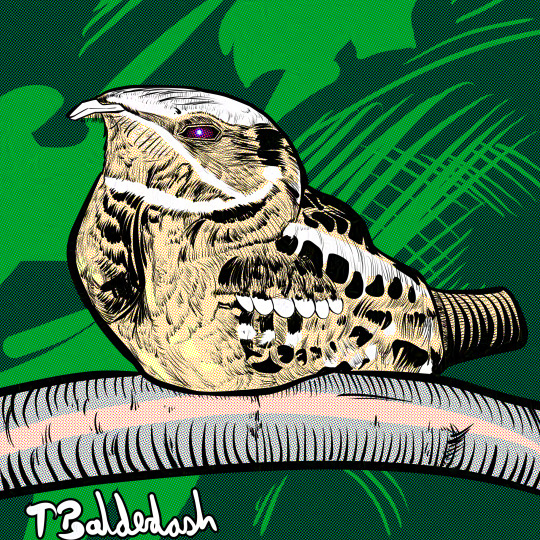#Antrostomus carolinensis
Explore tagged Tumblr posts
Text

Migratory May Day 9: Chuck-Will's-Widow
Reference photo by Michael Stubblefield
#migratory may#chuck-will's-widow#nightjar#antrostomus carolinensis#antrostomus#caprimulgidae#caprimulgiformes#strisores#bird#birds#birb#birbs#bird art#art#digital art#artists on tumblr#tw eyestrain#cw eyestrain#wauk wauk
266 notes
·
View notes
Photo

Chuck-will's-widow (Antrostomus carolinensis)
© Marcus Kelly
89 notes
·
View notes
Text

Chuck-will's-widow Antrostomus carolinensis
This quite literally took me over a year. All those feather markings really takes it out of you. Long breaks were necessary! But, I'm excited to finally add this guy to my sci-illustration portfolio c:
234 notes
·
View notes
Text

[2418/11080] Chuck-will's-widow - Antrostomus carolinensis
Order: Caprimulgiformes (nightjars) Family: Caprimulgidae Subfamily: Caprimulginae (typical nightjars)
Photo credit: Sam Wilson via Macaulay Library
#birds#Chuck-will's-widow#Caprimulgiformes#Caprimulgidae#Caprimulginae#Antrostomus#birds a to z#undescribed
225 notes
·
View notes
Video
Chuck-will's-widow (Antrostomus carolinensis) portrait, Green Cay Nature Preserve. by pedro lastra
1 note
·
View note
Photo

Antrostomus carolinensis by Eric Heisey
#bird#birds#animal#animals#biology#nature#wildlife#fauna#Caprimulgiformes#Caprimulgidae#Antrostomus#Antrostomus carolinensis
285 notes
·
View notes
Video
tumblr
This is a chuck-will's-widow (Antrostomus carolinensis) that we have at the rehab! This one lost a wing so it can't be released. If we can acclimate it to humans, it will likely become an ambassador bird (don't quote me on that, though). They're a nocturnal species and they catch food while flying, so they have a HUGE mouth and an almost sort of hissing sound that is very startling at first but very fun once you get used to it.
I just thought it was a cool bird and wanted to share.
http://www.austinareawildliferehab.org/
#austin area wildlife rehabilitation#wildlife rehabilitation#bird#chuck wills widow#chuck will's widow#chuck-will's-widow#antrostomus carolinensis#aawr
54 notes
·
View notes
Photo

Chuck-Will's-Widow / Tapacamino de Paso (Antrostomus carolinensis)
0 notes
Photo

Chuck-will’s-widow (Antrostomus carolinensis), John James Audubon
3 notes
·
View notes
Photo

Bird of the Week: Chuck-will's-widow
Chuck-will’s-widow belongs to a family of birds with the folk name “goatsuckers.” The family name, Caprimulgidae, literally means “milker of goats” and is based on an ancient belief that the birds milked goats with their enormous mouths each night.
In reality, the birds’ attraction to livestock was likely due to the presence of insects. Chuck-will’s-widow forages at dusk and dawn, silently swooping over the ground in search of prey. Specialized feathers known as rictal bristles help funnel insects into the bird’s mouth, which is so large that they may occasionally swallow small birds and bats as well!
The “chuck” is the largest nightjar in North America and is almost entirely nocturnal. During the day, the birds roost along tree branches or on the ground, where their beautifully mottled brown plumage provides perfect camouflage against dried leaves and tree bark.
Chuck-will's-widows do not build nests, instead laying their eggs on the ground among dead leaves, pine needles, or on bare dirt. Incubating adults are almost invisible against the forest floor and only flush off their nests when closely approached.
Since they have a highly insectivorous diet, Chuck-will's-widows are impacted by pesticide use. They are sometimes killed by cars when they land on roads at night to pick up grit. Habitat loss on both breeding and wintering grounds is also a continual threat.
This nightjar winters in lowland forests throughout the Caribbean, Mexico, and Central America, where it shares habitat with Wood Thrush, Kentucky and Prothonotary warblers, and Painted Bunting. Chuck-will’s-widow is benefiting from ABC’s efforts to "bring back the birds" in these areas, with our focus on conserving geographically linked habitats both north and south.
(via American Bird Conservancy)
#Chuck-will's-widow#Antrostomus carolinensis#Antrostomus#Caprimulgidae#Caprimulgiformes#Cypselomorphae#Aves#birds#nightjar#conservation
55 notes
·
View notes
Photo

Chuck-Will's-Widow / Tapacamino de Paso (Antrostomus carolinensis) - ♂ © Miguel "Siu" for www.panamawildlife.net
0 notes
